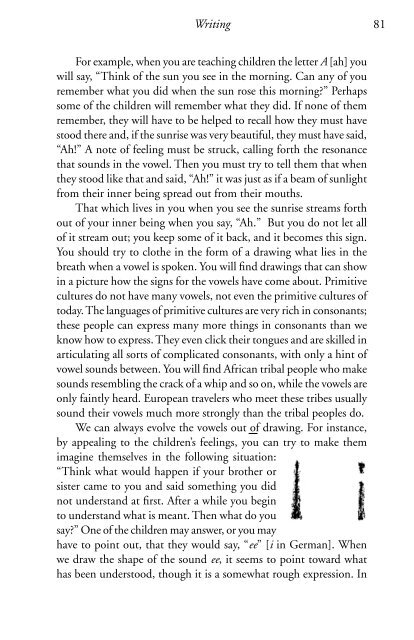Teaching Language arTs in The WaLdorf schooL
Teaching Language arTs in The WaLdorf schooL
Teaching Language arTs in The WaLdorf schooL
Create successful ePaper yourself
Turn your PDF publications into a flip-book with our unique Google optimized e-Paper software.
Writ<strong>in</strong>g<br />
81<br />
For example, when you are teach<strong>in</strong>g children the letter A [ah] you<br />
will say, “Th<strong>in</strong>k of the sun you see <strong>in</strong> the morn<strong>in</strong>g. Can any of you<br />
remember what you did when the sun rose this morn<strong>in</strong>g?” Perhaps<br />
some of the children will remember what they did. If none of them<br />
remember, they will have to be helped to recall how they must have<br />
stood there and, if the sunrise was very beautiful, they must have said,<br />
“Ah!” A note of feel<strong>in</strong>g must be struck, call<strong>in</strong>g forth the resonance<br />
that sounds <strong>in</strong> the vowel. <strong>The</strong>n you must try to tell them that when<br />
they stood like that and said, “Ah!” it was just as if a beam of sunlight<br />
from their <strong>in</strong>ner be<strong>in</strong>g spread out from their mouths.<br />
That which lives <strong>in</strong> you when you see the sunrise streams forth<br />
out of your <strong>in</strong>ner be<strong>in</strong>g when you say, “Ah.” But you do not let all<br />
of it stream out; you keep some of it back, and it becomes this sign.<br />
You should try to clothe <strong>in</strong> the form of a draw<strong>in</strong>g what lies <strong>in</strong> the<br />
breath when a vowel is spoken. You will f<strong>in</strong>d draw<strong>in</strong>gs that can show<br />
<strong>in</strong> a picture how the signs for the vowels have come about. Primitive<br />
cultures do not have many vowels, not even the primitive cultures of<br />
today. <strong>The</strong> languages of primitive cultures are very rich <strong>in</strong> consonants;<br />
these people can express many more th<strong>in</strong>gs <strong>in</strong> consonants than we<br />
know how to express. <strong>The</strong>y even click their tongues and are skilled <strong>in</strong><br />
articulat<strong>in</strong>g all sorts of complicated consonants, with only a h<strong>in</strong>t of<br />
vowel sounds between. You will f<strong>in</strong>d African tribal people who make<br />
sounds resembl<strong>in</strong>g the crack of a whip and so on, while the vowels are<br />
only fa<strong>in</strong>tly heard. European travelers who meet these tribes usually<br />
sound their vowels much more strongly than the tribal peoples do.<br />
We can always evolve the vowels out of draw<strong>in</strong>g. For <strong>in</strong>stance,<br />
by appeal<strong>in</strong>g to the children’s feel<strong>in</strong>gs, you can try to make them<br />
imag<strong>in</strong>e themselves <strong>in</strong> the follow<strong>in</strong>g situation:<br />
“Th<strong>in</strong>k what would happen if your brother or<br />
sister came to you and said someth<strong>in</strong>g you did<br />
not understand at first. After a while you beg<strong>in</strong><br />
to understand what is meant. <strong>The</strong>n what do you<br />
say?” One of the children may answer, or you may<br />
have to po<strong>in</strong>t out, that they would say, “ee” [i <strong>in</strong> German]. When<br />
we draw the shape of the sound ee, it seems to po<strong>in</strong>t toward what<br />
has been understood, though it is a somewhat rough expression. In

















